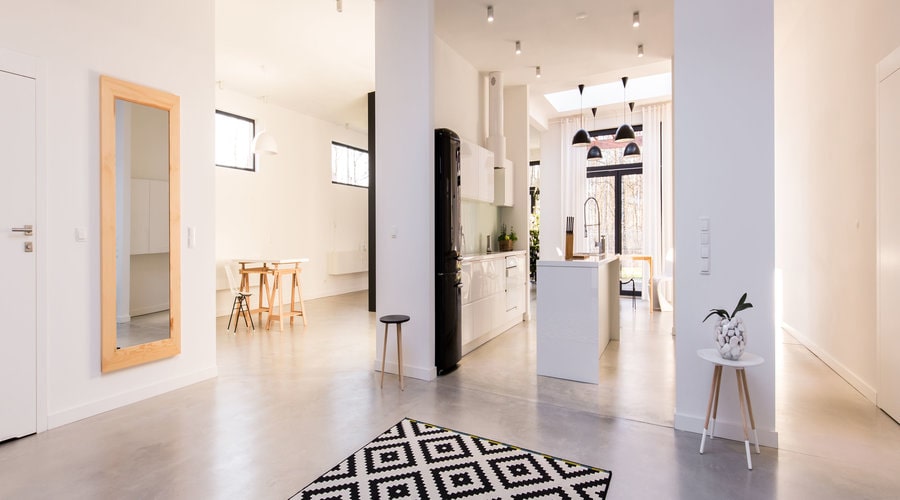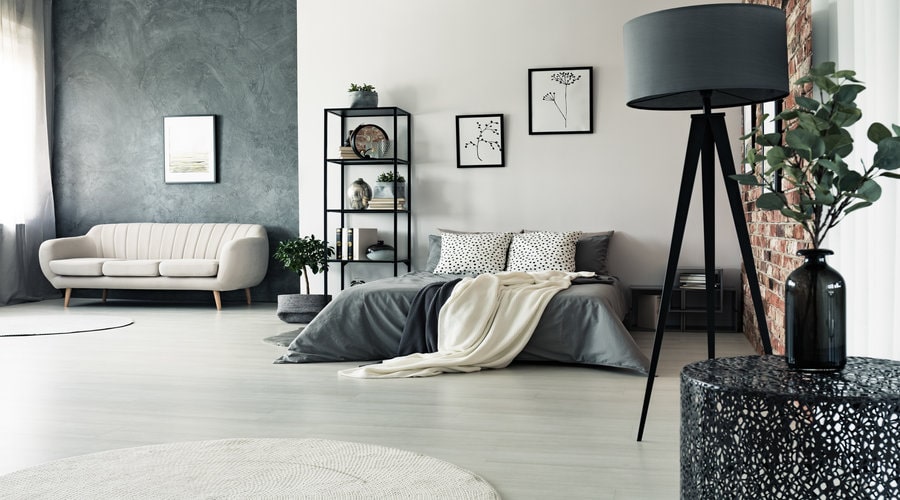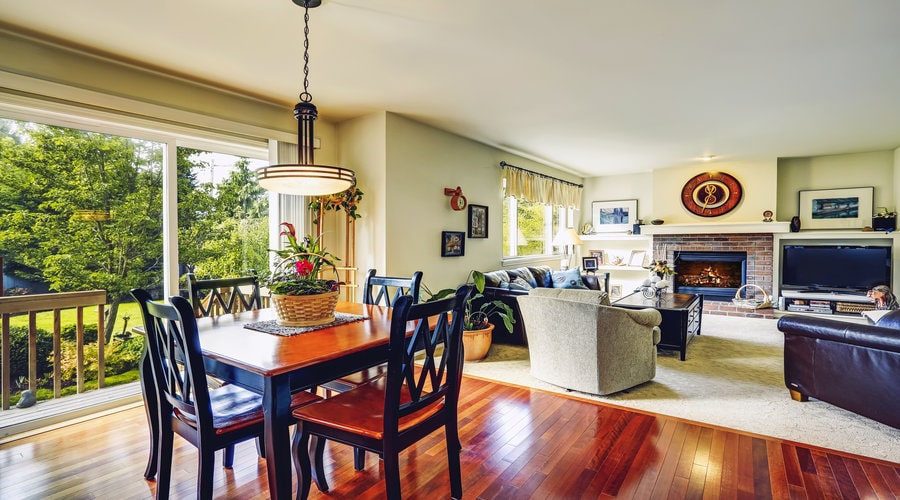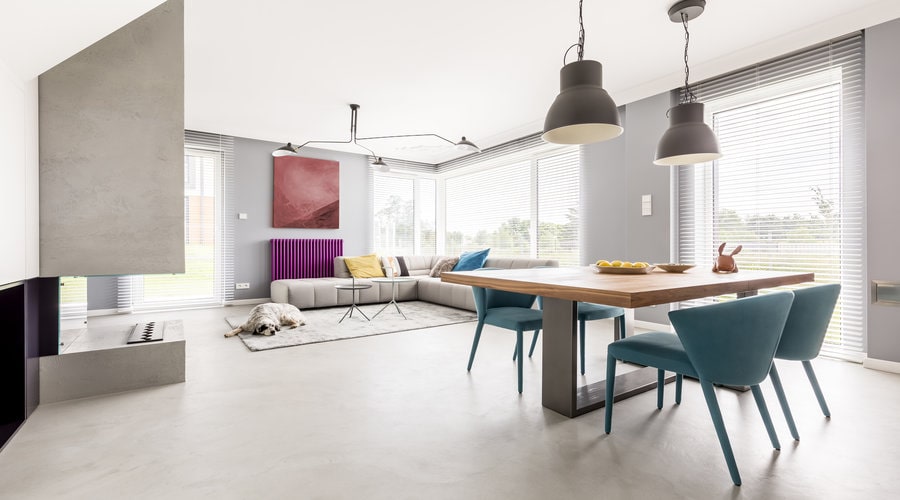How To Pick A Colour Scheme For An Open Floor Plan

The open floor plan layout is growing more and more popular these days, and for good reason! By combining different living areas into one connected space, this open plan brings people together, as well as providing plenty of natural light. For smaller homes the open floor plan does wonders, making the smaller space appear larger, which is a must for most potential homeowners or renters.
Though desirable, pulling off this open interior plan is no easy task, with the biggest challenge being how to decorate this larger space. For instance, you’ll want not only to consider your décor and furniture but ensure that you’re picking a complementary colour scheme that includes your walls and ceiling.
Putting too much colour into an open floor plan becomes overwhelming while choosing the wrong colour can make the whole area seem dull, smaller and boring. It’s a balancing act and while choosing the right colour scheme for your open floor plan living area may seem like a daunting task, we’ve put together some helpful tips to make choosing the correct colour scheme to paint and decorate your open living space a breeze.
Tips For Open Plan Colour Schemes

1.Stick to a single colour
When choosing how to paint your new space we mentioned above that too much colour could become overwhelming. That’s why you’ll want to keep things simple and often stick to one colour when painting your new space. A neutral colour is always a safe choice as it will allow you to get more creative with your furnishing and let your walls become a mere backdrop for your unique taste and style. However, picking a neutral hue doesn’t always mean going with a lighter colour as natural and artificial lighting can contribute to the overall mood and feel of your space.
Even if you’ve gone with one colour, the lighting of the space will change the hues tone from one area to the next. An example being, what looks green in one light may look a dark blue in another. Use this to your advantage or get to know your lighting as you may need to choose a colour based on the shadows and the warmth of your light sources.
2.Tone up
If you’re interested in adding a bit of flair to your backdrop, why not try using different tones to give your living area walls a bit of uniqueness. Start by using a lighter colour and build up to a darker tone as you move from one section of the space to another. Keep in mind that you should stick to one colour and merely change its intensity to create this look. This approach is an excellent option for those looking for a subtle yet charming look for their open-plan space.
3.Use strong accent colours

Even though it’s always easiest to keep your walls and ceilings neutral, there's no reason why you shouldn’t add a bold accent colour to highlight certain areas of the space. Making use of a pop of colour in strategic places like behind the sofa or the stove will add levels to your space and will create a stopping point in when looking over the room.
Using bright colours to break up space is always a good choice and, can even bring a sense of comfort to the room. If you are a fan of strong accent colours, painting an entire wall or two can be an excellent idea additional to your painting plan.
4.Get acquainted with the colour wheel
If you’re new to painting and need a quick lesson on colour theory, then look no further than the colour wheel. This simple device instantly lets you see which colours complement each other and will assist in creating your colour scheme from scratch. For example, groups of colours that sit opposite from each other on the colour wheel are called complementary and can be used together to create a bright but appealing look. While triadic colours schemes use three different colours, all equally spaced out on the colour wheel to create the same vibrant look with a greater sense of balance.
5.Make use of various finishes
If you’re not a fan of using too much colour, try selecting a decorative finish to add some texture to your space. Choose from striping, sponging or colour washing and even implement the same colour just with a smoother finish to establish your chosen colour scheme.
For example, if you’ve used a lighter accent colour to strip or sponge wall, you might continue using that lighter colour to paint the next wall. Using finishes can create a bold and striking look; particularly with smaller open floor planned homes.
6.Connect the spaces with soft neutrals

Unfortunately, while neutral colours are your safest bet, they often have a reputation of being the generic pick when it comes to styling a room. However, these soft neutrals can do wonders when it comes to painting open-plan spaces. Soft neutrals with warmer undertones place more emphasise on the textural or architectural details of your walls. While also playing a dynamic role in creating a welcoming atmosphere and, providing visual relief against accent walls or vivid palettes.
7.Outline or unite
While some homeowners like to use the right palette of colour to outline particular areas in an open floor plan, others use colour as a to unite the fragmented space. A bright accent wall in the living space that matches your kitchen cabinets is a great way to connect two completely different spaces, while a bright pendant lamp fixture matching the dining area will create an instant visual flow between the two items.
While the outlined approach is used to accent each room in your open floor space and easily allows guests to identify the beginning and end to each room.
8.Incorporate colour asymmetry in unexpected places
If you're looking to reimagine your open floor plan space without buying a brand new set of furniture, why not try a pop of colour in an unexpected place to completely change the rooms.
Choose vibrant colours to highlight statement pieces or unconventional areas such as the tops of your shelves. Paint both vertically and horizontally to create a dynamic and eye-catching space. Focus on window panes, inside doorways, areas of the ceilings and even your staircases to spice up your living area and create a space that’s one of a kind.
9.Share architectural features

Another innovative way to utilise colour in an open floor plan is by using darker shades to break up the interior. While softer tones like creams and greys are great for the walls, painting your window frames in a darker blue or black is a sophisticated addition to any interior design.
Ceiling beams can also be painted a darker colour to lead eyes from one room to next, while painting large bookcases in your living space with a similar finish or colour to the kitchen cabinets, will help your space seamlessly blend.
Radiators, or ducts, are often painted as the same colour as the wall but can be turned into a statement piece with a pop of colour. For instance, having a sunflower-yellow radiator in your living area almost doubles as a sculpture and provides a cheerful bit of colour for winter days.
Many houses these days are built or are renovated to include an open floor plan. To create a stylish and comfortable living environment, be sure to use the painting tips above in addition to your furniture and décor to create your perfect colour scheme in no time.









